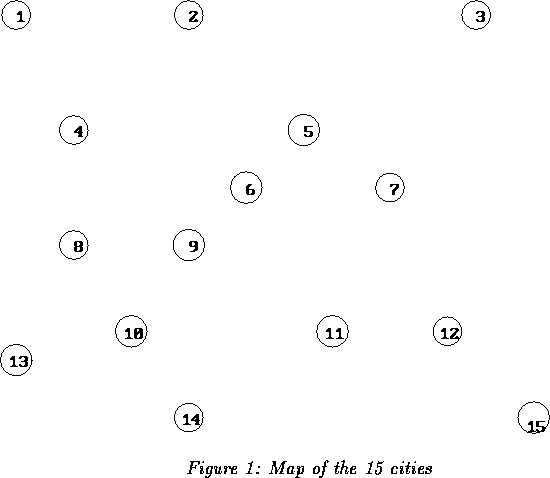
Exercise 1: The formulation is:

Exercise 2: Let ![]() be a 0,1 variable which equals 1 if route
j is used, 0 otherwise. Then the vehicle routing problem can be formulated
as a set covering problem:
be a 0,1 variable which equals 1 if route
j is used, 0 otherwise. Then the vehicle routing problem can be formulated
as a set covering problem:
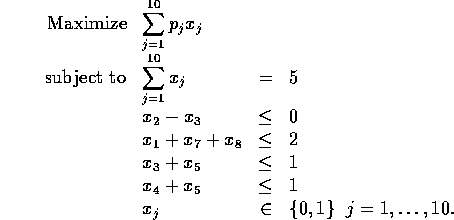
Exercise 3: Let 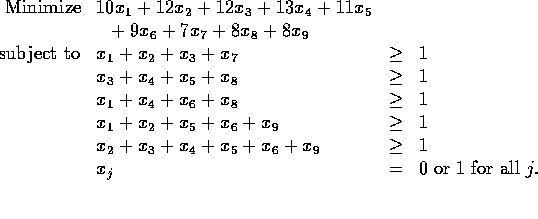 starting time of operation j.
starting time of operation j.
![]()
Then the formulation is:
![]()
The first set of constraints are the precedence constraints and the last two sets are the noninterference constraints.
Exercise 4: First we solve the problem as a linear program with LINDO.
The solution is 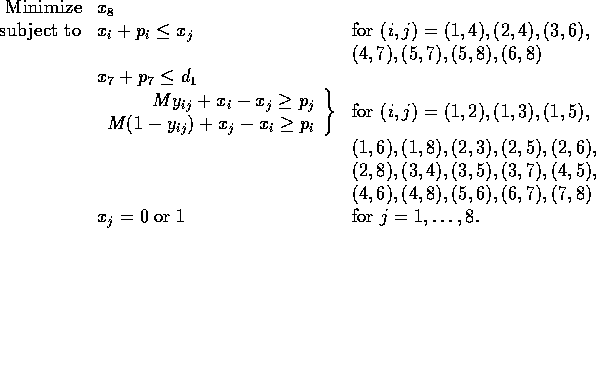 ,
, ![]() . Rounding it yields
. Rounding it yields ![]() ,
,
![]() which fails to satisfy the constraint
which fails to satisfy the constraint ![]() .
.
In fact, the only feasible integer solution is
![]()
and it cannot be obtained by simple rounding.
Exercise 5: The enumeration tree is given in Figure 9.
Three optimum integer solutions were found, namely
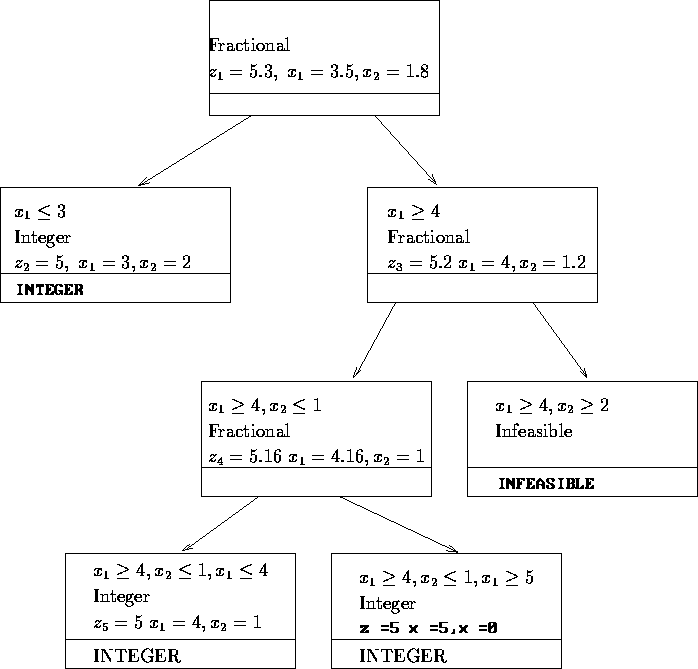
each with value z=5.
Exercise 6
From the enumeration tree of Exercise 5, we see that only one branching is
necessary since both subproblems  and
and ![]() are inactive by reason of
integrality. The better solution is
are inactive by reason of
integrality. The better solution is ![]() with value
with value ![]() .
.
Exercise 7
MAX 4 X1 + 7 X2 + 6 X3 + 5 X4 + 4 X5
SUBJECT TO
2) 5 X1 + 8 X2 + 3 X3 + 2 X4 + 7 X5 <= 112
3) X1 + 8 X2 + 6 X3 + 5 X4 + 4 X5 <= 109
END
GIN 5
ENUMERATION COMPLETE. BRANCHES= 6 PIVOTS= 20
OBJECTIVE FUNCTION VALUE 151.000
VARIABLE VALUE REDUCED COST
X1 14.000 -4.000
X2 .000 -7.000
X3 .000 -6.000
X4 19.000 -5.000
X5 .000 -4.000
Exercise 8
Since ![]() does not satisfy the knapsack constraint
does not satisfy the knapsack constraint
![]() , it follows that
, it follows that ![]() must hold for all solutions of the knapsack problem.
must hold for all solutions of the knapsack problem.
Similarly for ![]() .
.
MAX 8 X1 + 11 X2 + 6 X3 + 4 X4
SUBJECT TO
2) 5 X1 + 7 X2 + 4 X3 + 3 X4 <= 14
3) X1 + X2 + X3 <= 2
3) X1 + X2 + X4 <= 2
END
SUB X1 1
SUB X2 1
SUB X3 1
SUB X4 1
OBJECTIVE FUNCTION VALUE 21.000
VARIABLE VALUE REDUCED COST
X1 .000 0.000
X2 1.000 -3.000
X3 1.000 -2.000
X4 1.000 0.000
Exercise 9.
(a) Nearest Neighbor starting from city 1 yields the tour
1 - 4 - 8 - 9 - 10 - 13 - 14 - 11 - 12 - 15 - 7 - 5 - 6 - 2 - 3 - 1
of length 89.
Applying 2-opt, we get the following improvements: replace 1-3 and 2-6 by 1-2 and 3-6 for a gain of 6. The new tour is
1 - 2 - 3 - 6 - 5 - 7 - 15 - 12 - 11 - 14 - 13 - 10 - 9 - 8 - 4 - 1
Replace 3-6 and 5-7 by 3-5 and 6-7 for a gain of 2. The new tour
1 - 2 - 3 - 5 - 6 - 7 - 15 - 12 - 11 - 14 - 13 - 10 - 9 - 8 - 4 - 1
has lenth 81.
(b) We start Nearest Insertion with the tour 5 - 6 - 5 of length 6.
Then we insert city 7 at a cost of 4+5-3=6 (note that there is a tie. We could have inserted city 9 instead). The new tour is 5 - 6 - 7 - 5. Then the nodes are inserted in the following order: 9 (between 6 and 7), 11 (between 7 and 9), 12 (between 7 and 11), 10 (between 9 and 11), 14 (between 10 and 11), 8 (between 9 and 10), 13 (between 8 and 10), 4 (between 8 and 9), 2 (between 4 and 9 ), 1 (between 2 and 4), 15 (between 11 and 12) and finally 3 (between 5 and 7). The resulting tour is
1 - 2 - 9 - 6 - 5 - 3 - 7 - 12 - 15 - 11 - 14 - 10 - 13 - 8 - 4 - 1
and has length 79. There is no improvement with 2-opt.
(c) We start Furthest Insertion with the tour 1 - 15 - 1 of length 46. Then city 3 is inserted followed by city 13. The new tour is 1 - 3 - 15 - 13 with length 60. The remaining nodes are inserted in the folowing order: 6 (between 13 and 15), 14 (between 6 and 13), 5 (between 6 and 15), 11 (between 5 and 15), 7 (between 5 and 11), 10 (between 13 and 14), 9 (between 6 and 14), 12 (between 11 and 15), 12 (between 11 and 15), 4 (between 1 and 13), 8 (between 4 and 13) and finally 2 (between 1 and 3). The resulting tour
1 - 2 - 3 - 15 - 12 - 11 - 7 - 5 - 6 - 9 - 14 - 10 - 13 - 8 - 4 - 1
has length 81. There is no improvement with 2-opt.
(d) We take as the central point on the map the midpoint between 5 and 10. The resulting tour obtained by applying the sweep heuristic is
7 - 3 - 5 - 6 - 2 - 1 - 4 - 8 - 9 - 13 - 10 - 14 - 11 - 15 - 12 - 7
and it has length 80.
Applying the 2-opt heuristic, we replace 9-13 and 10-14 by 9-10 and 13-14, thus reducing the length of the tour by 1. The new tour
1 - 2 - 6 - 5 - 3 - 7 - 12 - 15 - 11 - 14 - 13 - 10 - 9 - 8 - 4 - 1
has length 79.